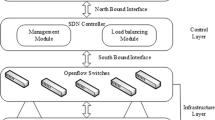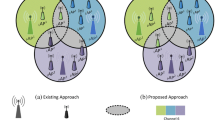Abstract
A wireless LAN (WLAN)-based Internet service, called NESPOT, of Korea Telecom (KT), the biggest telecommunication and Internet service company in Korea, has been operational since early 2002. As the numbers of subscribers and deployed access points (APs) increase, KT has been endeavoring to improve its service quality as well as the network management. In this paper, we introduce a joint effort between Seoul National University (SNU) and KT to achieve it. We have been addressing two major issues as part of the joint project thus far: (1) a unified WLAN management/maintenance tool; and (2) real-time traffic support enhancement. We present our on-going efforts as well as some preliminary results. Some issues, which need further attention for the future NESPOT service enhancement, are also introduced.
Similar content being viewed by others
References
AirSnort, http://airsnort.shmoo.com, online link.
S. Choi, J. del Prado, S. Shankar and S. Mangold, IEEE 802.11e Contention-Based Channel Access (EDCF) Performance Evaluation in Proceedings of IEEE ICC’03, Anchorage Alaska USA IEEE May 2003.
draft-ietf-pppext-eap-ttls-02, EAP Tunneled TLS Authentication Protocol (EAP-TTLS), (November 2002).
ETSI TR 101 957, HIPERLAN/2; Requirements and Architecture for Interworking between HIPERLAN/2 and 3rd Generation Cellular Systems, ETSI (Aug. 2001).
G.107, 159, ITU-T SG12; The E-Model, a computational model for use in transmission planning, (December 1998) ITU.
3GPP TSG SA WG1, http://www.3gpp.org/TB/SA/SA1/SA1.htm, online link.
B. O’Hara and A. Petrick, The IEEE 802.11 Handbook: A Designer’s Companion, Standards Information Network, (IEEE Press, 1999).
IEEE Working Group (WG), http://www.ieee802.org/11 online link.
IEEE Std. 802.11-1999, Part 11: Wireless LAN Medium Access Control (MAC) and Physical Layer (PHY) specifications, Reference number ISO/IEC 8802-11:1999(E), IEEE Std 802.11, 1999 edition IEEE (1999).
IEEE Std. 802.11a, Supplement to Part 11: Wireless LAN Medium Access Control (MAC) and Physical Layer (PHY) specifications: High-speed Physical Layer in the 5 GHZ Band, IEEE Std. 802.11a-1999 IEEE (1999).
IEEE Std. 802.11b, Supplement to Part 11: Wireless LAN Medium Access Control (MAC) and Physical Layer (PHY) specifications: Higher-speed Physical Layer Extension in the 2.4 GHz Band, IEEE Std. 802.11b–1999 IEEE (1999).
IEEE 802.11e/D6.0, Draft Supplement to Part 11: Wireless Medium Access Control (MAC) and physical layer (PHY) specifications: Medium Access Control (MAC) Enhancements for Quality of Service (QoS) IEEE 802.11 WG (Nov. 2003).
IEEE 802.11f, Trial-Use Recommended Practice for Multi-Vendor Access Point Interoperability via an Inter-Access Point Protocol Across Distribution System Supporting IEEE 802.11 Operation IEEE (June 2003).
IEEE Std. 802.11g, Supplement to Part 11: Wireless LAN Medium Access Control (MAC) and Physical Layer (PHY) specifications: Further Higher-Speed Physical Layer Extension in the 2.4 GHz Band IEEE (June 2003).
IEEE 802.11i/D7.0, Draft Supplement to Part 11: Wireless LAN Medium Access Control (MAC) and Physical Layer (PHY) specifications: Medium Access Control (MAC) Security Enhancements IEEE 802.11 WG (Oct. 2003).
IEEE 802.11k/D0.9, Draft Supplement to Part 11: Wireless LAN Medium Access Control (MAC) and Physical Layer (PHY) specifications: Specification for Radio Resource Measurement, IEEE 802.11 WG (Dec. 2003).
A. Jain, D. Qiao and K.G. Shin, RT-WLAN: A soft real-time extension to the ORiNOCO linux device driver, to appear in Proceedings of IEEE PIMRC’2003, Beijing, China, IEEE, Sept. 7–10 (2003.
I. Katzela and M. Naghshineh, Channel Assignment Schemes for Cellular Mobile Telecommunication Systems: A Comprehensive Survey, IEEE personal communications (June 1996).
D. Kim, S. Kim, H. Jung and S. Gweon, WLAN Interference reduction method by channel assignment with field test results, in Proceedings of JCCI’03, Anmyundo, Korea (April 2003).
KT NESPOT, http://first.nespot.com/english/web/, online link.
Y.-K. Lee and D. Lee, Broadband Access Korea: Experience and future perspective, IEEE Communication Magazine (December 2003) 30–36.
J. Malinen, Host AP driver for Intersil Prism2/2.5/3, http://hostap.epitest.fi/, online link.
RFC 3411, An Architecture for Describing Simple Network Management Protocol (SNMP) Management Frameworks, (December 2002).
Spectralink, http://www.spectralink.com, online link.
Author information
Authors and Affiliations
Corresponding author
Additional information
The work reported in this paper was financed and supported by KT. Any opinions, findings, and conclusions or recommendations expressed in this publication are those of the authors and do not necessarily reflect the views of KT.
Youngkyu Choi is an M.S. candidate in the department of electrical engineering at Seoul National University (SNU), Seoul, Korea. He received his B.S. with honors in electrical engineering from SNU in 2002. He has a lot of project experiences related with system software development. His current research interests are the design of MAC layer from distributed system to centralized cellular system, resource management in next-generation (4G) cellular system, and mathematical analysis of system performance. He had served in the Korean Army for 3 years from 1998.
Sekyu Park is a research staff at the Multimedia & Wireless Networking Lab. (MWNL), Seoul National University (SNU), Seoul, Korea. Before joining MWNL in September 2003, he was with MMC Technology, Seoul, Korea as a Research Staff for five years. His current research interests are in the area of wireless/mobile networks and embedded OS.
Sunghyun Choi is an assistant professor at the School of Electrical Engineering, Seoul National University (SNU), Seoul, Korea. Before joining SNU in September 2002, he was with Philips Research USA, Briarcliff Manor, New York, USA as a Senior Member Research Staff and a project leader for three years. He received his B.S. (summa cum laude) and M.S. degrees in electrical engineering from Korea Advanced Institute of Science and Technology (KAIST) in 1992 and 1994, respectively, and received Ph.D. at the Department of Electrical Engineering and Computer Science, The University of Michigan, Ann Arbor in September, 1999. His current research interests are in the area of wireless/mobile networks with emphasis on the QoS guarantee and adaptation, resource management, wireless LAN and PAN, next-generation mobile networks, data link layer protocols, and connection and mobility management. He authored/coauthored over 45 technical papers and book chapters in the areas of wireless/mobile networks and communications. He is the technical program co-chair for ACM International Workshop on Wireless Mobile Applications and Services on WLAN Hotspots (WMASH’2004). He is currently serving on program committees of a number of leading wireless and networking conferences including IEEE INFOCOM, IEEE GLOBECOM, and IEEE VTC. He is also a guest co-editor for a special issue on “Emerging WLAN Applications and Technologies” of Wiley Wireless Communications and Mobile Computing Journal. He is an active participant and contributor of the IEEE 802.11 WLAN standardization committee. Dr. Choi was a recipient of the Korea Foundation for Advanced Studies Scholarship and the Korean Government Overseas Scholarship during 1997–1999 and 1994–1997, respectively.
Go Woon Lee is a researcher at Service Development Laboratory, Korea Telecom (KT), Seoul, Korea. She received her B.S. degrees in computer science and material engineering from Korea Advanced Institute of Science and Technology (KAIST) in 1995. She was with Microsoft Korea R&D Group as a research staff in 1995. She received M.S. degree in information & communication from Kwang-Ju Institute of Science and Technology (K-JIST) in 1998. Her current research interests are in the area of wireless/mobile networks with emphasis on data link layer protocols, remote diagnosis, and wireless service management.
Jaehwan Lee is a researcher at Korea Telecom (KT), Seoul, Korea. He received his B.S. and M.S. degrees in electrical engineering from Seoul National University (SNU) in 1998 and 2000, respectively. His master’s research was about estimation theory related to Global Positioning System (GPS) and image processing in robot soccer. His current research interest is to analyze and enhance the performance of wireless/mobile networks (IEEE 802.11, sensor networks and mobile ad-hoc networks) regarding QoS, energy-efficiency and high-throughput considering hand-off and inter-networking with heterogeneous networks. Before joining wireless LAN group in KT, he developed the Web-GIS (Geographical Information System) client-server system from 2000 to 2001.
Hanwook Jung, Ph.D joined KT in 1985 and got his Ph.D degree with the company finalcial scholarship of KT from 1991 to 1996 at SUNY at Buffalo. His thesis is about “Wireless signal transmission over Fiber by subcarrier multiplexing” which is current heavily utilized for PCS and cellular repeater line. From 1985 to 1991, he had developed a Videotex service which is now known as Hitel. From 1996 to 1999, he developed 26GHz broadband wireless local loop system and contributed to get the license from the government. Since 1999, he has led a business model and service with wireless LAN. The KT Wi-Fi public service, “NESPOT” has 300,000 subscribers and 10,000 public hotspots. In 2003 he was promoted as an assistant vice president leading NESPOT research team to enhance KT’s broadband with 5,000,000 subscribers. His vision regarding next generation communications service is believed to be true by combining the broadband access and wireless technology including WiFi wireless LAN, UWB, and bluetooth in those areas such as wireless home-networking, device-to-device communications, and ubiqutous networking.
Rights and permissions
About this article
Cite this article
Choi, Y., Park, S., Choi, S. et al. Enhancement of a WLAN-Based Internet Service. Mobile Netw Appl 10, 303–314 (2005). https://doi.org/10.1007/s11036-005-6424-2
Issue Date:
DOI: https://doi.org/10.1007/s11036-005-6424-2




